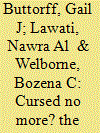| Srl | Item |
| 1 |
ID:
163237


|
|
|
|
|
| Summary/Abstract |
Recent scholarship posits that the resource curse has gendered as well as economic effects on oil-rich economies, like those in the Middle East and North Africa, entrenching paternalistic relationships that disadvantage women’s entry into the labor force. Upon closer examination, however, it appears that oil may not be the most compelling argument to explain Arab women’s low presence in the workforce –– especially since women’s labor-force participation within the oil rich Gulf Cooperation Council (GCC) states is generally higher than the regional average. We contend that this is, in part, a byproduct of the countries’ labor nationalization policies. Our analysis suggests that oil-driven development can in fact boost female labor force participation, revealing that rentierism as experienced in the GCC can actually have positive externalities for women
|
|
|
|
|
|
|
|
|
|
|
|
|
|
|
|
| 2 |
ID:
193285


|
|
|
|
|
| Summary/Abstract |
This paper explores the link between the prevalence of violent conflicts and the extremely low female labor force participation rates observed in South Asian countries. The Labor Force Surveys from Bangladesh, Sri Lanka, India, and Pakistan are merged with the Global Terrorism Database to estimate the effect of terrorist attacks on female labor supply. We exploit the geographical variation in exposure to violence to compare administrative units exposed to events with those not exposed. We find that for each wounded and killed person, female labor force participation falls 0.000026 and 0.0001 percentage point, respectively, while male labor force participation remains unchanged, thus widening the gender labor participation gap. We test the non-linearity of various violence effects, finding that the deterring effect is higher in administrative units with higher baseline FLFP rates. We also provide suggestive evidence that terrorism has a negative effect on the intensive margin of female labor supply.
|
|
|
|
|
|
|
|
|
|
|
|
|
|
|
|